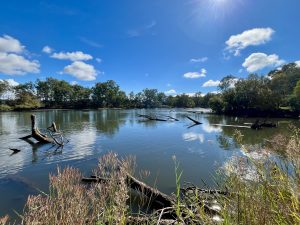Our slow walks in Baranduda and Castle Creek in the past week were a treat, with cold foggy starts giving way to sunshine, something to fascinate everyone and lots of knowledge shared along the way.
Different barks and buds, insect casings and hidey holes, different terrains, tree species natural and planted, the history of the reserves and future needs of nature, identifying flowers, grasses, birds, bees and insects – despite not walking far at all, we certainly covered a lot of ground!

In both reserves, the early wattles are already in bloom. We found Acacia dealbata (Silver wattle), A. ulicifolia (Juniper wattle), A. verniciflua (Varnish wattle) flowering. With at least 6 Acacia species in this reserve, and their flowering times spread across the seasons, there is plenty more to come! We looked at some of the characteristics – leaf and phyllode arrangement, glands, flowers – that help us to distinguish one species from another.
Also flowering were an abundance of Drosera – an insectivorous plant seen here in winter and spring, particularly. They are a spectacular looking plant, especially when the sun catches the sticky droplets that cover the leaves – which is how they get their common name – “sundews”.
Some of the ‘pea’ species are already flowering as well – we saw common hovea, showy parrot-pea and hop bitter-pea. Eucalypts were fragrant with flower and, along with banksia, busy with bees, while on the ground layer urn heath and buttercups demonstrated some of the many yellows of the bush palette.
Throughout, we saw and heard an abundance of birds; our list from Baranduda alone included Red Wattlebird, Eastern Spinebill, Thornbills, Brown headed Honeyeater, Yellow-faced Honeyeater, Crimson Rosella, Restless Flycatcher, Butcher bird, Blue wrens, Grey Fantail, and White-winged Choughs.
All in all, the walks blew away the misconception that nothing much happens in the bush in winter. With this much going on in July, what can we look forward to in spring!






